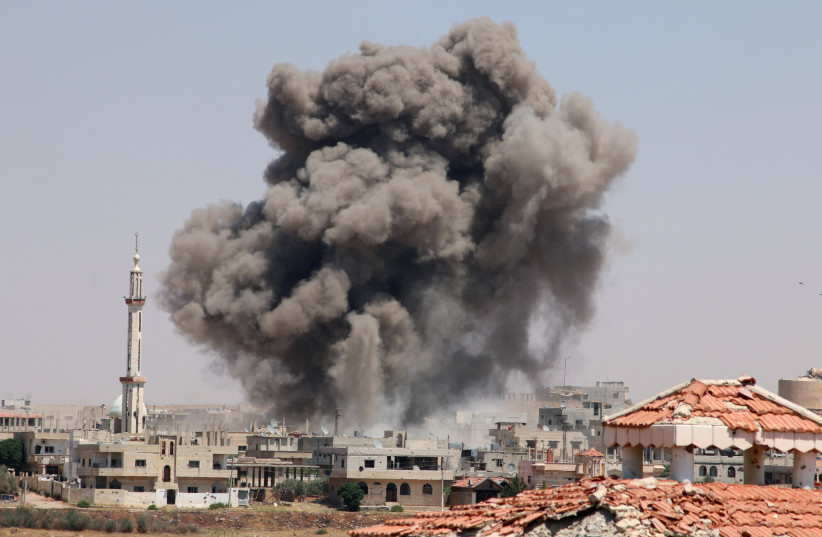On Tuesday evening, sometime after midnight Iraqi time, reports came in that airstrikes struck in the Iraq-Syria border area.
Videos circulating showed fire at the border crossing between Albukamal in Syria and Al-Qaim in Iraq. It remained unclear if an airstrike had taken place or if something else happened. The crossing is a key location and, since late 2017, has been a conduit for Iran to extend its influence across Iraq into Syria and to Lebanon.
The rumors of an airstrike, which some local commentators blamed on the US, is interesting because it comes amid heightened concerns about Iran’s role in the region and also the Iran-Russia relationship.
Iran has exported drones to Russia in its war against Ukraine, a fact that Tehran has now admitted after many months of denial. These are mostly the Shahed 136 drone, but there may be others.
Rather than sacrificing expensive Russian weaponry or aircraft, the kamikaze drones enable Moscow to wreak havoc on Ukrainians without paying the price.

Russia pays for Iranian drones in cash
A Sky News report said that Russia gave Iran some $141 million in cash and sent captured US and UK weapon systems “in return for dozens of deadly drones... a security source has claimed.”
This is one of the first reports to indicate what Russia paid for the drones it acquired. This comes amid rising concerns that Iran may supply Russia with more weapons, like ballistic missiles.
How would the missiles be transported and would the US or others seek to interdict this movement of dangerous weapons to Russia? What about the air defenses Ukraine needs to stop missiles from raining down on Ukraine during the tough winter months?
As Iran and Russia contemplate the next move, there is another corridor that Iran may be exploiting to spread chaos in the region.
Over the last several years, Iran moved its proxy groups into Al-Bukamal. Kataib Hezbollah set up a headquarters in the Syrian border in 2018. The headquarters was hit by an airstrike.
In 2019, reports said that Iran was looking to move ballistic missiles to Iraq and base them in the western desert with proxy groups. Few weapons depots were hit by airstrikes that year.
Iraqi-based pro-Iranian militias at the time blamed Israel for the airstrikes. This came in the context of rising tensions between the US and Iran as well; Iran had targeted ships in the Gulf of Oman in May and June 2019 and by the fall of 2019 pro-Iranian militias in Iraq were frequently targeting US forces with rockets.
By 2020, things had shifted again. The US killed IRGC Quds force commander Qasem Soleimani and Iran retaliated with ballistic missiles targeted at the Al-Asad base in Iraq. Iran also used missiles in 2018 to target Kurdish dissident groups in Koya in 2018.
In September of this year, amid raging protests in Iran, Tehran used drones, artillery and rockets to target Kurds in northern Iraq. Iran also used drones to target US forces in Syria.
This is the context for Iran’s operations out of Albukmal – linking the Iraqi and Iranian nexus in Syria and Lebanon. Iran also built a base called Imam Ali at the border in 2019, but it may have abandoned some of that base by November 2021. Despite some investment in 2020 in a tunnel at the base, reports about Iran’s influence in the area have shifted now to focus on points between Al-Bukamal and Deir Ezzor.
Another issue here is Iran’s basing of drones in Syria. It has moved drones to T-4 base near Palmyra in 2017 and early 2018 and targeted Israel with a drone in February of that year.
By April 2018 it attempted to move its third Khordad air defense system to the T-4 base, which an airstrike allegedly destroyed. By 2021, Iran shifted its drone threats to include Iraq and in May 2021 Iran used a drone flown from Iraq to target Israel.
In March 2021, Iran flew drones over Syria targeting Israel; Israel shot them down with F-35s. In August of this year Iran’s nefarious activities in Syria became so pronounced the US carried out two rounds of airstrikes against the proxies in Syria.
With the Iran-Russia connection in focus, any Iranian exportation of drones and missiles in the region takes on more urgency.
Iran is becoming a global drone power and if Iran also sends missiles to Russia this would be another escalation. Additionally, any report of cash inflows from Russia to Iran could aid Iran in supplying its nexus of proxies in Iraq, Syria, Yemen and Lebanon.